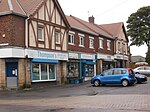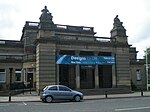Eastwood Gardens
Eastwood Gardens is a cricket ground in Gateshead, England which, like Feethams Cricket Ground, Grangefield Road, The Racecourse, Park Drive and Ropery Lane, was used by the Durham 1st XI between 1992 and 1994 prior to The Riverside Ground being built, since which it has not seen any 1st XI action. In 1992, the ground hosted two County Championship matches and one Sunday match, while in 1993 and 1994 the ground hosted one match in each of those two competitions. Eastwood Gardens is the home of Gateshead Fell Cricket Club one of the top Club teams in the North East of England. The ground has hosted 4 first-class matches and 5 List A matches. Game Information: Game Statistics: first-class: Game Statistics: one-day matches:
Excerpt from the Wikipedia article Eastwood Gardens (License: CC BY-SA 3.0, Authors).Eastwood Gardens
Eastwood Gardens,
Geographical coordinates (GPS) Address Website External links Nearby Places Show on map
Geographical coordinates (GPS)
| Latitude | Longitude |
|---|---|
| N 54.942188888889 ° | E -1.5939916666667 ° |
Address
Gateshead Fell Cricket Club
Eastwood Gardens
NE9 5UB , Deckham
England, United Kingdom
Open on Google Maps










